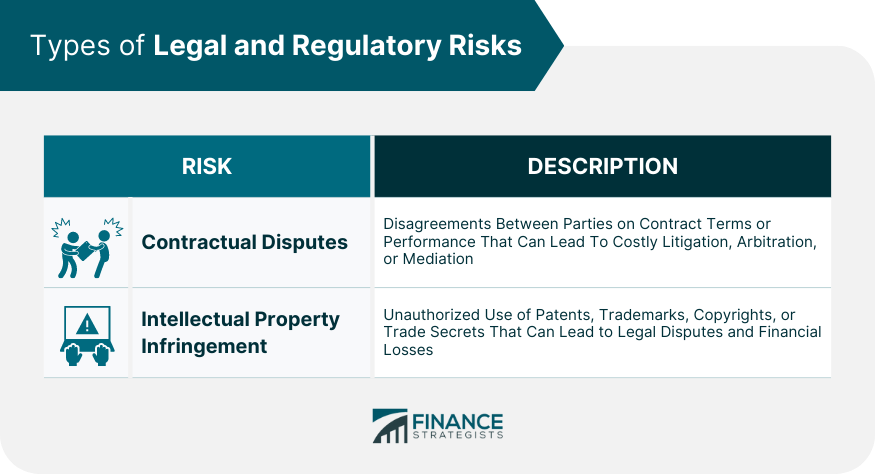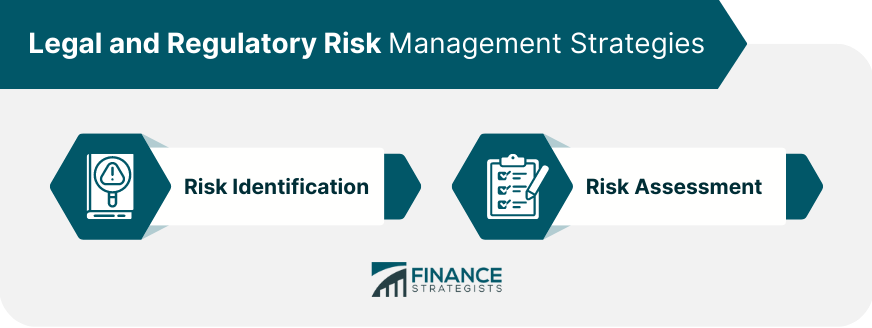Legal risk refers to the potential financial loss that may arise due to non-compliance with laws, regulations, or contractual obligations. It includes exposure to lawsuits, fines, and reputational damage. Legal risk management is essential for organizations to ensure compliance and to minimize the potential for financial loss. Understanding legal risks allows businesses to proactively address issues before they become significant problems. Regulatory risk is the potential for financial loss due to changes in government regulations or enforcement actions. It can also result from the failure to comply with existing regulations or to adapt to new regulations. Managing regulatory risk is crucial for businesses operating in highly regulated industries, as non-compliance can lead to penalties, fines, and reputational damage. Businesses need to stay updated on regulatory changes and ensure that they have processes in place to maintain compliance. Contractual disputes occur when parties disagree on the terms of a contract or the performance of contractual obligations. These disputes can lead to litigation, arbitration, or mediation, which can be costly and time-consuming. Resolving contractual disputes can be a lengthy process, but businesses can mitigate this risk by drafting clear and comprehensive contracts, engaging in effective negotiation, and actively managing contracts throughout their life cycle. Intellectual property (IP) infringement involves the unauthorized use of another's intellectual property, such as patents, trademarks, copyrights, or trade secrets. IP infringement can lead to legal disputes and significant financial losses for businesses. To protect against IP infringement, businesses should establish robust IP management systems and actively monitor for potential infringements. Additionally, they should ensure that their employees understand the importance of respecting others' IP rights. Risk identification involves the process of recognizing and documenting potential legal and regulatory risks that may impact a business. This process helps organizations prioritize risks and develop appropriate risk management strategies. By identifying risks early, businesses can take proactive steps to mitigate potential legal and regulatory issues. Regular risk assessments and ongoing monitoring of the risk environment are crucial to effective risk identification. Risk assessment is the process of evaluating the potential impact and likelihood of legal and regulatory risks. It helps businesses determine which risks are most critical and prioritize resources to address them. A comprehensive risk assessment should consider the organization's size, industry, and risk tolerance. Regularly updating risk assessments allows businesses to adapt their risk management strategies to changing regulatory landscapes and business environments. The board of directors plays a critical role in overseeing legal and regulatory risk management. They are responsible for setting the organization's risk appetite and ensuring that appropriate risk management systems are in place. Boards should regularly review the organization's risk management policies and procedures and ensure that they are aligned with the organization's overall strategic objectives. They should also be informed about significant legal and regulatory risks and the steps management is taking to address them. Senior management is responsible for implementing legal and regulatory risk management strategies throughout the organization. They must establish a culture of compliance and ensure that employees understand their role in managing legal and regulatory risks. Senior management should regularly communicate with the board of directors about the organization's risk management efforts and any significant legal or regulatory issues. They should also allocate sufficient resources to legal and compliance departments to ensure effective risk management. The financial services industry faces numerous legal and regulatory risks, including anti-money laundering (AML) regulations, consumer protection laws, and data privacy requirements. Non-compliance with these regulations can result in significant fines and reputational damage. Financial institutions must implement robust compliance programs and invest in technology to monitor and manage legal and regulatory risks. By staying informed about regulatory changes and maintaining effective risk management systems, financial services firms can mitigate their exposure to these risks. The health care industry is subject to complex regulations, such as the Health Insurance Portability and Accountability Act (HIPAA) and the False Claims Act. Non-compliance with these regulations can lead to penalties, fines, and reputational harm. Health care providers must implement comprehensive compliance programs and provide ongoing training to employees to ensure they understand their legal and regulatory obligations. By actively managing legal and regulatory risks, health care organizations can maintain compliance and minimize potential financial losses. Globalization has led to an increase in cross-border transactions, which can expose businesses to legal and regulatory risks in multiple jurisdictions. These risks can be challenging to manage due to differences in legal systems, regulations, and enforcement practices. To effectively manage cross-border legal and regulatory risks, businesses must develop a deep understanding of the regulatory environments in which they operate and implement tailored risk management strategies for each jurisdiction. Engaging local legal counsel and compliance experts can help businesses navigate complex international regulatory landscapes. International regulatory cooperation aims to promote consistency in regulations across jurisdictions and reduce regulatory barriers to trade. However, it can also lead to changes in domestic regulations, creating new legal and regulatory risks for businesses. Organizations should actively participate in international regulatory cooperation initiatives and monitor developments in global regulations. By staying informed about changes in international regulations, businesses can adapt their risk management strategies and maintain compliance across jurisdictions. The regulatory landscape is constantly evolving, driven by changes in technology, globalization, and societal expectations. Businesses must be prepared to adapt their risk management strategies to address emerging legal and regulatory risks. Staying informed about regulatory changes and trends is critical for businesses to maintain compliance and minimize legal and regulatory risks. By continually updating their risk management strategies, organizations can effectively navigate the evolving regulatory landscape and protect their interests. Environmental, social, and governance (ESG) factors are becoming increasingly important in the regulatory landscape, as governments and investors recognize the need to address pressing global challenges such as climate change, social inequality, and corporate governance issues. Businesses should incorporate ESG factors into their legal and regulatory risk management strategies to stay ahead of emerging risks and seize opportunities in the rapidly changing ESG landscape. Definition of Legal and Regulatory Risk
Types of Legal and Regulatory Risks
Contractual Disputes
Intellectual Property Infringement

Legal and Regulatory Risk Management Strategies
Risk Identification
Risk Assessment

Organizational Approaches to Legal and Regulatory Risk Management
Role of the Board of Directors
Role of Senior Management
Legal and Regulatory Risk Case Studies
Financial Services Industry
Health Care Industry
Impact of Globalization on Legal and Regulatory Risk
Cross-Border Transactions
International Regulatory Cooperation
Final Thoughts
Legal and Regulatory Risk FAQs
Legal and regulatory risk refers to the potential harm to a business due to non-compliance with laws, regulations, or legal obligations.
Types of legal and regulatory risk include operational risk, strategic risk, financial risk, reputational risk, and compliance risk.
Businesses can manage legal and regulatory risk by implementing effective compliance programs, conducting regular risk assessments, and staying up to date on relevant laws and regulations.
Examples of legal and regulatory risks include violation of environmental regulations, non-compliance with employment laws, failure to maintain proper licenses and permits, and non-compliance with financial reporting requirements.
The consequences of legal and regulatory risk can include fines, legal liability, damage to reputation, loss of business opportunities, and even criminal penalties in some cases.
True Tamplin is a published author, public speaker, CEO of UpDigital, and founder of Finance Strategists.
True is a Certified Educator in Personal Finance (CEPF®), author of The Handy Financial Ratios Guide, a member of the Society for Advancing Business Editing and Writing, contributes to his financial education site, Finance Strategists, and has spoken to various financial communities such as the CFA Institute, as well as university students like his Alma mater, Biola University, where he received a bachelor of science in business and data analytics.
To learn more about True, visit his personal website or view his author profiles on Amazon, Nasdaq and Forbes.















